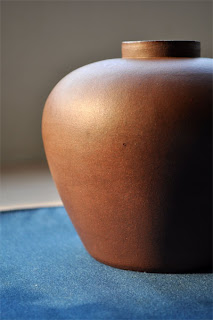
 Having sold out my 2006 Qizhong Oolong, I am looking for a replacement for this medium roasted Wenshan Baozhong. Here, I received a promising sample from the same source. It's a 2008 'subtropical forest' Baozhong (one with a slightly stronger oxidation) that has been similarly roasted this January.
Having sold out my 2006 Qizhong Oolong, I am looking for a replacement for this medium roasted Wenshan Baozhong. Here, I received a promising sample from the same source. It's a 2008 'subtropical forest' Baozhong (one with a slightly stronger oxidation) that has been similarly roasted this January.I've compared it with the 2006 and it's indeed very close in its level of 'fire' and aromas. I just found it a little bitter and lacking refinement. The 2006 had mellowed down in the meantime. On the other hand, this newly roasted has more energy thanks to its recent roast.
These leaves have a very nice potential and are very close to what I am looking for. Maybe they just need to rest a year or two. Or, maybe I can find a way to make them smoother much faster?!
Through a happy coincidence, I recently purchased this traditional, handmade and wood fired Yixing zisha jar. Hundreds of tiny imperfections visible up close show this piece has some age. Its clay is so smooth and firm! The round shape is a such a pleasure to hold and caress... But I disgress!
From my previous storage experiment with jars, I remembered that Yixing clay can absorb some of the fire from roasted leaves. So, I wanted to see how this beautiful jar would impact this 2008 Qizhong Oolong.
After spending just 30 minutes in the jar, I brewed 3 grams from this jar, from the plastic foil and from
 this antique hexagonal hungni jar. I liked its shape and pressed design. Also, its workmanship is incredible. The walls are very thin and it weighs just 270 grams, much less than the zisha jar (470 grams).
this antique hexagonal hungni jar. I liked its shape and pressed design. Also, its workmanship is incredible. The walls are very thin and it weighs just 270 grams, much less than the zisha jar (470 grams).The result was stunning. The Yixing jar had made a huge impact on the smoothness and refinement of the Qizhong Oolong. The fire has been tamed. There was still some bitterness in the brew. To get rid of it, I had to keep the leaves in the jar for 2 days.
With the Hungni jar, I was less lucky. The brew lost some of its transparency and became a little cloudy. The tea's fragrance was spoiled. It wasn't a real surprise, though. When I bought this jar, it was almost black. I had to clean it with hot water, baking powder and a tooth brush. The inside still smelled humid and dusty (it must have spent the last 50-100 years in a basement storage). To cure this problem, I rinse it regularly with fresh water and place it on a terrace under direct sunshine. It seems to get better.
Later, I also experimented with my best glazed jar. It also made the tea smoother, less firy. But while the Yixing would take a little substance away, the glazed jar would refine the aromas and keep its intensity! For a medium roast and several days of storage, it was better to use the glazed jar. But for the immediate results, the Yixing jar gave me a faster improvement.
Conclusion: I will add this tea to my selection and I suggest you also experiment with its storage. If you don't have a jar, I suggest you use a teapot or a gaiwan and see the difference for yourself!




When you say it is too much roasted, does it mean the roast is not harmonious?
ReplyDeleteFor instance, your Top Roasted Tie Gian Yin (Spring 2005) has a great roast taste; isn't it like this Baozhong?
When you put your Baozhong in a Yixing jar, and afterwards another tea, isn't the second tea affected by the smell of the previous one?
Iulius,
ReplyDelete1. the roast of this Baozhong is much lighter than the top roasted Tie Guan Yin. You can see it at the open leaves. They open up completely and their color didn't darken very much. Also, there are no burnt or charcoal fragrances in these leaves. (This could happen to a medium roast with a short but too strong roast). However, the roasting is still young and one feels some uncontrolled energy and dryness in the brew. It takes time (or the right storage) to dissipate.
2. The Yixing jar will indeed retain the fragrance of the tea it stored. So, to avoid this, before putting another tea inside, I recommend to empty it thoroughly and let it air out. (No cover). After a while, the smell should dissipate. You could also rinse it with water and dry it under the sun if the smell persists.
Another trick is to start with placing a few leaves of the new tea you want to store, in the jar. Then shake the jar with the leaves inside. This also help absorb previous fragrances.